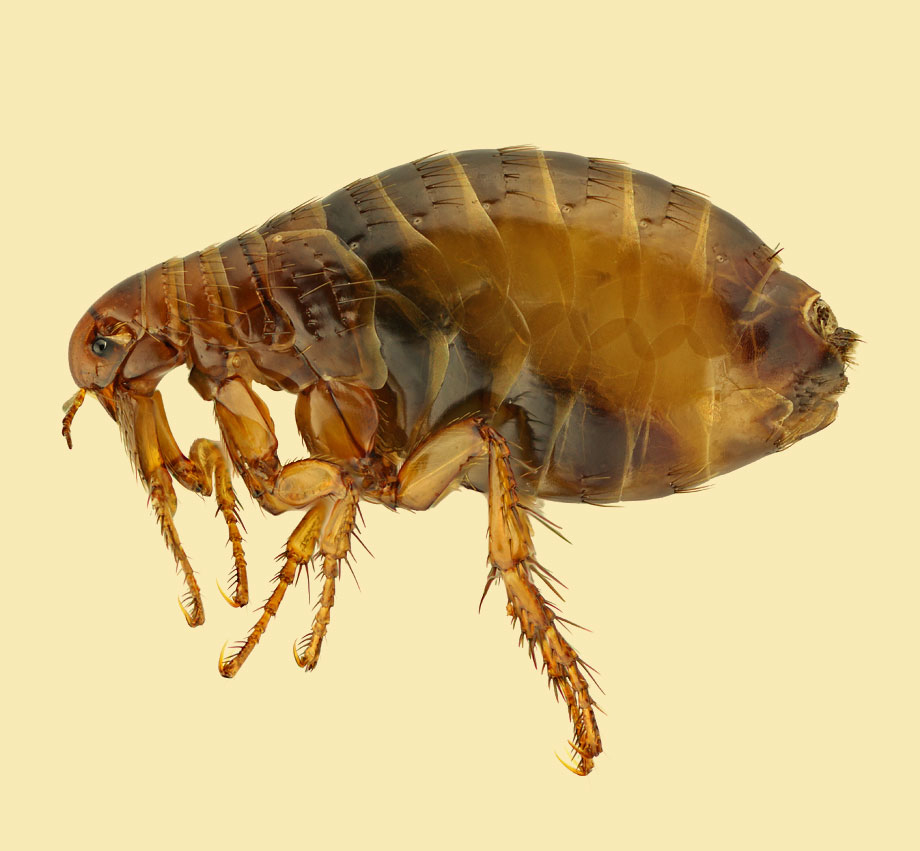Fleas
Identification
Fleas are easy to identify. Look for small (1/8 inch-long), wingless insects in the fur of dogs and cats. Adult fleas are brown to black in color, with strong jumping legs. Adult cat fleas feed on dogs, cats, and a variety of furred animals. People may be bitten by fleas, especially when populations are high, but fleas will not live and reproduce on humans.
Control
Flea control is best achieved through a four step process. Good sanitation, pet treatment, premise treatment and follow-up are all critical to good flea control.
Sanitation. Frequent vacuuming and disrupting of flea breeding sites can help greatly in indoor flea control. Fleas lay eggs while on the pet. Eggs then drop off the animal into carpet, bedding, furniture, or onto the floor. After a few days the eggs hatch into very small, legless larvae. Partly digested blood that flakes continuously from a flea-infested pet is the main food source for larvae.
Thorough vacuuming with a good, beater-type vacuum can remove 15-30% of larvae and 30-60% of flea eggs from carpeting. In addition, vacuuming helps remove some of the flea larva’s food supply and straightens carpeting fibers, enhancing penetration of the carpet by insecticide sprays.
When vacuuming pay special attention to areas where the pet spends a lot of time. These are the sites most likely to harbor eggs, larvae, and the dried blood that larvae need. Don’t neglect to vacuum under furniture, cushions, chairs, beds, and along the edges of walls–favorite flea breeding sites. Be sure to discard your vacuum cleaner bag at least once a week when battling a flea problem. Fleas can continue to develop inside a vacuum cleaner bag and can reinfest the house.
Pet Treatment. Your pet’s first defense against fleas should include a flea comb and a good bath. Soap in a pet bath acts as a gentle insecticide and will help control lighter flea infestations. Use of a flea comb, though time consuming, can also help reduce the need for insecticides. Flea combs are fine-toothed combs designed to help remove adult fleas from the pet’s fur. Most dogs and cats seem to enjoy combing. When combing pay special attention to the face and neck regions, and the area in front of the tail. Dip the comb frequently in soapy water or an alcohol solution to kill any fleas removed from the pet.
Heavier, or chronic, infestations are best treated by a veterinarian. Your veterinarian knows what can be safely used on your pet, and can supply you with materials for home treatment.
Plant-derived, or botanical, insecticides kill adult and larval fleas and are relatively low in toxicity. Many are commonly sold over-the-counter. Botanical insecticides include pyrethrum (or pyrethrins) or citrus oil extracts (i.e., limonene and linalool). Once applied, these products break down in a relatively short time, leaving the pet with no residual protection against new fleas. Like all insecticides, these products should be used with care. When used properly they should pose little hazard to the pet or the applicator; however be aware that some cats may display sensitivity even to botanical insecticides, especially the citrus oil products.
Garlic, Brewer’s yeast, cedar bedding and various herbal collars and sachets are frequently promoted for flea control; however little scientific evidence exists to support such claims. Volatile oils in fresh cedar chips do have some insecticidal action against fleas, however the effective life of such chips is probably short. Brewer’s yeast has been tested and has not been shown to provide any protection to pets from fleas.
Premise treatments. While on-animal IGR treatments may reduce the need to treat your home, premise treatments applied to indoor or outdoor flea breeding sites are sometimes necessary. Ideally, premise treatments should be made at the same time as when the pet is treated. This is particularly important if pets have been treated with products that last only a short time.
Several good, low-toxicity treatments are available for indoor use. Citrus oil-based sprays containing limonene or linalool can be applied to rugs, carpeting, and pet bedding. These products act as contact poisons, killing only what they hit. After application they evaporate quickly, leaving a pleasant citrus smell, but little residual protection against emerging fleas. Follow-up treatments are usually necessary when using these and other botanical sprays, like pyrethrins.
Follow-up. Follow-up is especially important for flea control. The flea pupa is the intermediate life form between larval and adult life stages. The pupal stage normally lasts 7-14 days, but can persist for much longer under certain conditions. The pupa is normally well-protected from the effects of pesticide sprays and is very difficult to kill with insecticides. Fleas that are in the pupal stage when insecticides are applied, frequently survive treatment to emerge several days later. Hence follow-up treatments are usually needed. Two or more follow-up treatments with pyrethrum or a citrus oil-based spray (or a standard insecticide, if you wish) should be applied 5-10 days after the first application.
Don’t wait until fleas get out of hand to begin your flea control program. Start a frequent and thorough sanitation program, regularly inspect your pet for fleas, and carefully follow the label directions of whichever product you choose. And also call us for additional solutions.
